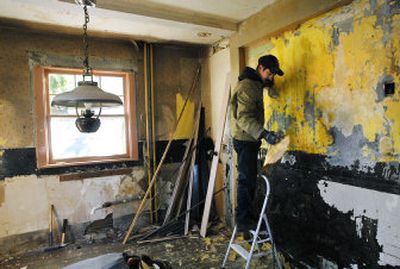Historic homes come of age

More homes are going on the historic register in Spokane under a program that has brought new life to old neighborhoods and given the city the distinction of being a place where age is considered beautiful.
Six homes are up for listing on the Spokane Register of Historic Places today They are among 87 properties recommended for the local city-county register over the past five years.
That is more than double the number of local historic listings over the previous five years and sets Spokane apart from other communities in the region where historic preservation is less prominent.
“There are fabulous neighborhoods in Spokane,” said Megan Duvall, who coordinates local historic listings for the state of Washington.
She said high-profile projects such as the rehabilitation of Spokane’s Davenport Hotel and the creation of a 900-home national historic district in Nettleton’s Addition on the city’s North Side have raised the visibility of historic preservation.
The visibility apparently has drawn more homeowners to the local register program, which offers property-tax incentives in exchange for legal limits on exterior alterations.
Spokane Valley opted out of the city-county program when it incorporated despite the fact that many of its ranch-style homes are reaching the 50-year minimum age for local register listings, and other older homes dot the landscape.
Elsewhere in Eastern Washington, new local register programs were recently set up in Colfax and Pomeroy to go along with existing ones in Cheney, Dayton, Ritzville, Kennewick and Walla Walla. Cheney has had two listings in the past three years, a member of that city’s historic-register panel said.
Across the border in North Idaho, property tax exemptions are not available. Kootenai County and the city of Priest River have lower-profile local preservation programs.
In Spokane, historic-home owner Toni Boggan said she waited for nearly 20 years to find her dream home in the Manito Park area. Her home at 2203 S. Manito Blvd. is among the six up for approval by the City Council today. Boggan and her husband, Thomas Crowley, were allowed to buy the home only after assuring the previous owner that they would protect the 1907 Craftsman, which was designed by renowned architect Kirtland Cutter and partner Karl Malmgren.
Boggan and Crowley have done a lot more than protect it. They spent about $250,000 installing a new period kitchen and baths and reinstalling original claw foot tubs, among other projects.
“Our contractor told us it would be way cheaper to tear our house down and build another one,” Boggan said.
Such talk is blasphemy for historic-home owners.
“We are doing everything we can to bring it back,” Boggan said. “I like how solid it feels. I like its sense of history.”
While the program offers 10-year property-tax exemptions on the value of qualified rehabilitations, many of the people involved in the restorations say they are doing it mainly to preserve their home’s significance, and that the tax break is of secondary value.
Historic preservation officials said the tax break makes sense because preservation is a public benefit.
For homeowners, a listing is considered a mark of pedigree that protects the property from future exterior changes. A listing does not prohibit a demolition; however, the city has restrictions on tearing down local register properties.
On the North Side, property owner Sharon Elias of California is teaming with friend and Spokane resident Michael Houbrick to restore an American Foursquare home at 2918 W. Sharp Ave.
Last week, workers were steaming layers of wallpaper off lath-and-plaster walls to rehabilitate a house that sat vacant for years.
“This is a labor of love,” Houbrick said, repeating a sentiment common among historic property owners. “It’s going to be a beautiful home.”
Houbrick, a Ferris High School graduate, returned to Spokane from California recently with an aim of fixing up old houses while working as a real estate agent.
“I think it’s an untapped gold mine for investors or people interested in living in them,” he said.